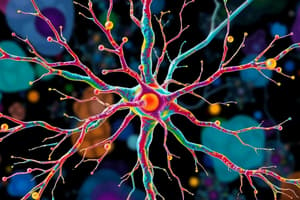Podcast
Questions and Answers
What is the central part of a neuron where the nucleus and other organelles reside?
What is the central part of a neuron where the nucleus and other organelles reside?
Which part of a neuron carries impulses away from the cell body towards target neurons or muscles?
Which part of a neuron carries impulses away from the cell body towards target neurons or muscles?
Which type of neuron carries signals from the brain or spinal cord to control voluntary muscle movements?
Which type of neuron carries signals from the brain or spinal cord to control voluntary muscle movements?
What are chemical messengers used by neurons to communicate with each other?
What are chemical messengers used by neurons to communicate with each other?
Signup and view all the answers
Which neurotransmitter is primarily involved in mood regulation?
Which neurotransmitter is primarily involved in mood regulation?
Signup and view all the answers
What are branched extensions of the cell body that receive incoming signals from other neurons?
What are branched extensions of the cell body that receive incoming signals from other neurons?
Signup and view all the answers
Where is the spinal cord located within the body?
Where is the spinal cord located within the body?
Signup and view all the answers
Which part of the brain is responsible for controlling movement and balance?
Which part of the brain is responsible for controlling movement and balance?
Signup and view all the answers
What is the function of the peripheral nervous system (PNS)?
What is the function of the peripheral nervous system (PNS)?
Signup and view all the answers
Which part of the nervous system serves as the command center for the body?
Which part of the nervous system serves as the command center for the body?
Signup and view all the answers
What is the main function of neurons in the nervous system?
What is the main function of neurons in the nervous system?
Signup and view all the answers
Which region of the brain is responsible for processing sensory information?
Which region of the brain is responsible for processing sensory information?
Signup and view all the answers
Study Notes
Nervous System and Neurons
The human nervous system is a complex network of specialized cells called neurons that communicate with each other to coordinate various bodily functions. At the core of this intricate system lies the brain and spinal cord, which make up the central nervous system (CNS), and the vast array of nerves that extend throughout our bodies, forming the peripheral nervous system (PNS).
Central Nervous System (CNS)
The CNS consists of two main parts: the brain and the spinal cord:
-
Brain: This is the largest component of the CNS and serves as the command center for our body, controlling all its functions and activities. It is divided into several regions, including the cerebrum, cerebellum, and brainstem, each responsible for specific tasks such as movement, balance, and processing sensory information.
-
Spinal Cord: Located within the vertebral column, the spinal cord extends from the base of the brain down to the lumbar region in adults. It transmits messages between different sections of the nervous system and plays a crucial role in motor functions like walking, reflexes, and temperature regulation.
Peripheral Nervous System (PNS)
Comprised of nerve fibers, ganglia, and plexuses, the PNS connects the CNS to all organs and tissues of the body. Its primary functions involve relaying information between the CNS and the rest of the body, allowing us to interact with our environment and maintain homeostasis.
Neuron Anatomy and Function
Neurons are unique cells that transmit information through electrical and chemical signals. They consist of three main components: the cell body, dendrites, and axon:
-
Cell Body: Also known as soma, this is the central part of the neuron where the nucleus and other organelles reside. Here, proteins and nutrients are synthesized for use in the surrounding structures.
-
Dendrites: These are branched extensions of the cell body that receive incoming signals from other neurons, often referred to as synapses. Dendrites can also initiate the release of neurotransmitters, which help facilitate communication between neurons.
-
Axon: A single, long extension from the cell body, the axon carries impulses away from the cell body towards target neurons or muscles. If necessary, these impulses may pass through multiple nerve cells before reaching their intended destination.
In addition to their basic structure, neurons play critical roles in information transfer and storage. For example, some neurons act as receptors, detecting changes in the external environment or internal conditions and converting them into electrical signals. Others, called interneurons, connect neurons within the same area, facilitating the integration of different types of information. Motor neurons, meanwhile, carry signals from the brain or spinal cord to control voluntary muscle movements.
Neurotransmitters
Neurotransmitters are chemical messengers used by neurons to communicate with one another. There are hundreds of known neurotransmitters, each playing distinct roles in various aspects of our physiology. Some common examples include dopamine, serotonin, norepinephrine, and acetylcholine, which are involved in mood regulation, sleep, motivation, memory, and learning, respectively.
In summary, the nervous system and its constituent neurons form a highly complex yet remarkably efficient network that enables the functioning of our bodies. From the central nervous system's ability to process and interpret information to the peripheral nervous system's role in coordinating physical actions, every aspect of our lives is influenced by the workings of these remarkable cells.
Studying That Suits You
Use AI to generate personalized quizzes and flashcards to suit your learning preferences.
Description
This quiz covers the fundamentals of the human nervous system, including the central and peripheral nervous systems, neuron anatomy, functions, and neurotransmitters. Test your knowledge on how these interconnected components work together to regulate bodily functions and facilitate communication throughout the body.




